PUBLIC TRANSPORT
SERVICES IN PORTSTEWART,
CO. LONDONDERRY,
NORTHERN IRELAND
|
John Henry (1780 - 1860)
|
| |
Had a grocery shop in the Diamond, Portstewart and operated a coach service to
Coleraine. The 1855 directory shows coaches from The Diamond to Coleraine continually during the summer season.
|
|
John Henry (1805 - 1844)
His son
|
|
Continued with the grocery and coach business. In the 1865 - 1866 directory
coach services are shown as follows:
Coleraine - Portstewart - Coleraine
Coleraine to Portstewart 9 a.m. and 4 p.m.
Portstewart to Coleraine 11 a.m. and 7 p.m.
Winter months (Sundays excepted)
Coleraine to Portstewart 11 a.m.
Portstewart to Coleraine 3 p.m.
These services may also have operated in earlier and later years.
Portstewart - Cromore (subsequently) - Portstewart railway station
The station opened in June 1855, the directory mentioned a four horse omnibus
which met all through trains to and from Belfast during the summer months. A one horse car attended during the winter (Sundays
excepted). As well as passengers the vehicles may have carried mails and goods. The tram service commenced on June 28th 1882,
and presumably it replaced the coach service.
General services, such as excursions to the Giant's Causeway were operated until cars
and charabancs replaced the horse in the early 1900s.
|
Samuel Reid Henry (1858 - 1944)
|
c.1881
|
Son of John (1805 - 1884). In his youth he was employed in his father's grocery
shop at the Diamond.
This business was transferred to him in 1877, and was presumably sold when the
Carrig-na-Cule Hotel and ground level shops were built c.1881 and operated by Mr. and Mrs. S. R. Henry.
Photo taken on the occasion of the opening of Portstewart Town Hall, 30th May
1935.
|

|
|
c.1890
|
Operated a service of Jaunting Cars and Horse Brakes, the stables were located at
the rear of the Windsor Guest House. |
|
1892 |
He was appointed Receiver of the Portstewart Tramway Company and he offered to
lease the tramway for a period of ten years at an annual rent of £100 per annum. He continued to operate the tram while
court proceedings were pending. |
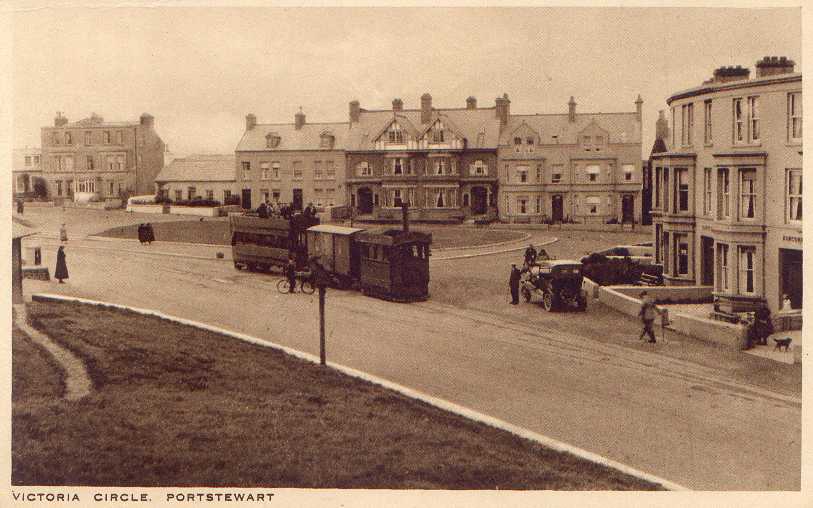
|
|
1897 |
The liquidator did not accept his proposition and the tramway was offered for
sale. The Belfast and Northern Counties Railway bid £2,100. The Receiver agreed that this would satisfy claims.
|
1906
|
A terrace of six houses (on a height above the stables) was built to house some
of his employees. This was called Stuart's Gardens after his son.
|
1914 |
A service of taxis, touring cars and lorries commenced (appendix A).
|
1920 |
Saw his first venture into charabancs
(appendix B). |
1922 |
A regular charabanc service to Portrush commenced, from April to October. |
1923 |
Hackney licences were issued to Portstewart operators (appendix C). |
|
Samuel Stuart Henry (1897 - 1965)
|
|
|
Son of Samuel Reid Henry. After service in the Royal Flying Corps, and spending a
year in a German prisoner of war camp, he returned home and became involved with the transport business.
Photo taken on 10th May 1917 |
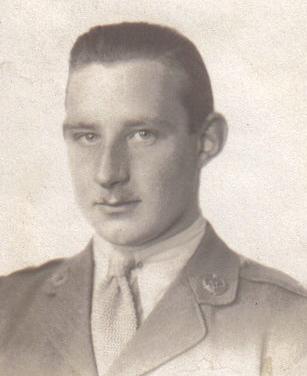
|
1923 |
S. R. Henry transferred the transport
business to him. |
|
1924 |
Another garage and workshop were built behind the Carrig na Cule hotel. |
1935 |
The bus, lorry and taxi business was nationalised by the Government on December
3rd, at this date he was the only private operator remaining in Co. Londonderry. |
|
Samuel Ronald Henry (1933 - 2016) |
|
2004 |
The author of this website, and the son of Samuel Stuart Henry. Photo taken in
November 2004. |

|
PREFACE
In my father's office there was a bundle of papers relating to the bus business. He told
me that someday he would explain this chapter in his life. Unfortunately that day never came, so now 39 years after his death, I
finally put pen to paper, or rather used my word processor!
In 1935 when the nationalisation took place the smaller operators felt they were not
getting a fair deal. The Provincial Hauliers Association was formed to negotiate a more acceptable compensation package, and the
records of Henry's Coast Tours were used to present the case to Arbitration.
BUSES and CHARABANCS
Records of the earlier vehicles are sparse, particularly of registration numbers on
earlier purchases and sales. I contacted Co. Londonderry motor tax department, however they refused to give any relevant information
on the grounds of state secrecy, this was for the period 1920 - 1935. Records kept by the Public Record Office of Northern Ireland,
of fares, routes and operators etc., were destroyed by them several years ago.
At the end of September each year, the Derry Central railway line was closed to Sunday
passenger traffic for the winter months. Special fares were offered to Portstewart Station. I remember in 1935 seeing most of the
bus fleet at the station from my grandparents house. There was a carnival atmosphere, in the pubs, cafes, shops, stalls etc. The day
was known locally as Chaghera Sunday (a compilation of Cookstown and Maghera).
All known details about the fleet can be seen in appendix B.
Specific items of mention are:
1. Most of the charabancs were purchased second-hand and when their useful life was
finished, they were converted into lorries by the employees retained during the winter months, or sold.
2. The first bus was GM 657, which was purchased from Steel and Ferguson (copy of the
invoice is shown in appendix D). The name on the side was HENRY'S MOTOR SERVICES, the only example of this name being used on a
vehicle, although the timetables have this heading.
3. At the date of the take-over only two buses were taxed, and other services were
carried out by the three taxis to provide a winter service.
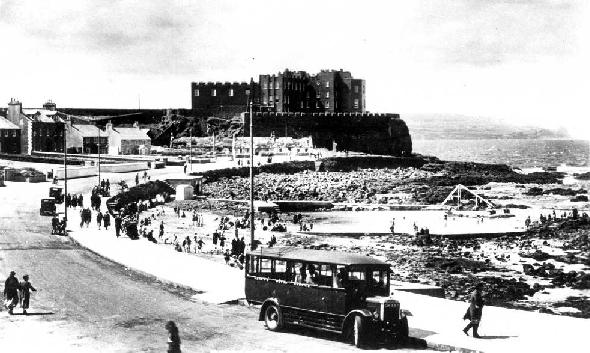
GM 657 at Portstewart Crescent in 1926.
This bus was first registered in March 1925 to Dundas Fyfe of Motherwell, then purchased
by S. S. Henry on 9th January 1926 to provide a service to Portstewart station, which commenced on 30th January. The fare was 3d
single, and the railway company paid an annual subsidy, as follows:
Year |
Subsidy |
Year |
Subsidy |
1926 |
£148 |
1931 |
£192 |
1927 |
£100 |
1932 |
unknown |
1928 - 1930 |
unknown |
|
|
In addition to the passengers, mail, parcels and freight were also carried. On 31st
December 1932 the Northern Counties Committee Railway (N. C. C.) decided to put their own bus on the run, however this only lasted
until 1st October 1935 when the Northern Ireland Road Transport Board (N. I. R. T. B.) was formed and operated the service.
The NIRTB paid £20 for GM 657 and later sold it to a dealer named G. Cook for
£3. Subsequently it was taxed by Lowe building contractors of Carryduff, Co. Down, they used it to transport their workers to
military sites during the 1939 - 1945 war and it was last taxed by them in March 1944; I was unable to trace it any further. A
remarkable vehicle, spanning a life of 20 years.
Another vehicle that deserves mention is IW 5068. It was rebodied by the N. I. R. T. B.
with the body of DZ 1399, formerly operated by W. Kerr of Toomebridge, Co. Antrim, and was sold by the UTA in 1949. I remember
seeing the rear of it from the top of a tramcar on the Newtownards Road, Belfast, in the late 1940s.
The late Brian Boyle's book (The Ulster Transport Authority 1948 - 1967, Buses in Ulster
volume 2) comments that this vehicle (renumbered N368) ran until December 1948 and reappeared for the July 1949 holiday period,
taxed for seven days only. At that date it was listed as withdrawn, being the last of the former private owners buses to survive.
The next record of it is in the hands of E. Linton, Deptford, London SE8, until
September 1951 (copy of original invoice can be seen at appendix E). I have a vague recollection of being told that IW 5068 was on
display at the Festival of Britain in 1951.
Ex S. S. Henry buses were the only IW (Co. Londonderry registration) ones in N. I. R. T.
B. livery, apart from two others which were taken over from H M S Catherwood.
VEHICLE LIVERY
Bodies:Red or maroon
Waistbands: Green
Roofs: Black
Wheels: Yellow
DRIVERS UNIFORMS
Cap: Black with white cover
Linen Coat: White
Rugs were provided, presumably on tours, or perhaps in the winter months. These were
sold for 3/- each in the auction of items not acquired by the N. I. R. T. B.
The late Brian Boyle told me that the fleet and the drivers always looked immaculate.
LORRIES
(Details in appendix A)
Five were acquired by the N. I. R. T. B.
Lorry receipts are as follows:
Period |
Income |
Year ended 30.11.1932 |
£ 560 18s 4d |
Year ended 30.11.1933 |
£1287 19s 8d |
Year ended 30.11.1934 |
£1016 19s 6d |
Year ended 3.12.1935 |
£1553 11s 6d |
(Note: the main income was derived from contracts, together with some casual work).
TAXIS and HIRE CARS
Taxi and Hire Car receipts:
Period |
Income |
Year ended 30.11.1932 |
£396 |
Year ended 30.11.1933 |
£354 |
Year ended 30.11.1934 |
£360 |
Year ended 3.12.1935 |
£376 |
Three taxis were taken over by the NIRTB.
SCHEDULED BUS ROUTES
|
ROUTE |
FARES |
|
Single |
Return |
|
Portstewart to Portrush 1930 |
2d |
3d |
|
Portstewart to Portrush 1935
(Intermediate stage fares were also available) |
5d |
7d |
|
Portstewart to Railway Station |
3d |
No return fare |
|
Portstewart to Golf Club*/Strand |
Adult 2d
Children 1d |
No return fare |
On 3rd December 1935 the issue of weekly and monthly tickets ceased.
* The Golf Club paid a subsidy of £15 per annum to convey players to the course.
DRIVERS RECORDS
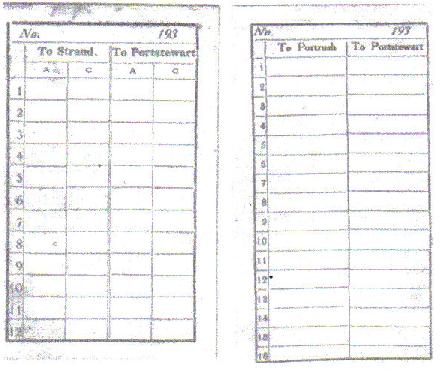
Examples of the bus driver's journey record cards for the Portrush and Strand services
are shown above:
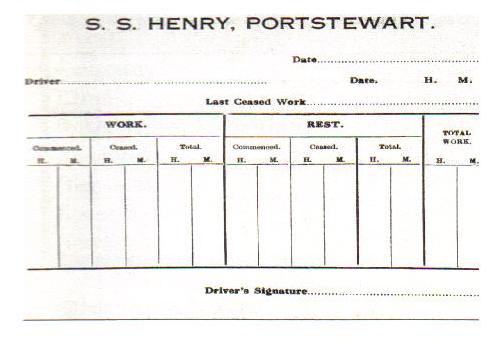
The lorry driver's card is depicted above:
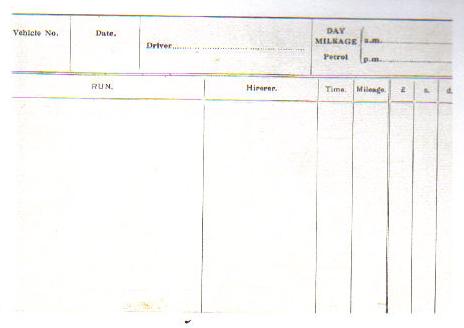
And finally the driver's record card used on tour duties:
BUS PASSENGERS and INCOME
Year ended |
30.11.1932 |
30.11.1933 |
30.11.1934 |
3.12.1935 |
Portrush route
Income |
93183
£1300 7s 10d |
101165
£1398 18s 9d |
121758
£1637 2s 6d |
126076
£1683 7s 4d |
Strand route
Income |
11106
£89 4s 5d |
16446
£124 14s 11d |
31979
£247 7s 6d |
34367
£264 6s 1d |
Portstewart station, including passengers, mails, newspapers and parcels |
£650 4s 0d |
£8 19s 11d
(One month only) |
|
|
Bus Hire |
£1136 18s 2d |
£1158 14s 5d |
£2094 11s 7d |
£1894 18s 7d |
Bus Tours |
£907 13s 7d |
£999 10s 9d |
£933 18s 7d |
£1044 8s 2d |
CONTRACT HIRE
Holiday Fellowship, Corrymeela, Ballycastle. During their holiday season a 32 seater bus
was garaged in Ballycastle, at a cost of £4 10s per annum. Daily rates were charged for the bus driver and fuel as follows:
Ballycastle to: |
Price |
Causeway |
£4 16s |
Glenarm |
£5 12s |
Buncrana |
£9 |
Whitepark Bay |
£2 8s |
Torr Head |
£4 16s |
Cushendun |
£4 12s |
Portrush |
£5 12s |
Magilligan |
£6 12s |
Rosapenna |
£14 10s |
The Fellowship set the price of individual fares. They took the risk/profit and Henry's
Coast Tours were guaranteed a fixed income.
A similar scheme was provided for the Irish Christian Endeavour Holiday Homes, Portrush.
Rates were as follows:
Route: |
Price |
Causeway |
£1 10s |
Larne |
£7 10s |
Rosapenna or Malin Head |
£9 5s |
Bundoran |
£10 5s |
Glenshesk |
£4 |
Buncrana |
£6 |
Newcastle |
£9 5s |
Other contracts were:
- Eucharistic Congress in Dublin, June 1932, when every available vehicle was chartered.
- Bann Drainage Scheme; buses transported workers to and from Kilrea and the income was £193 in 1933, and £873 in 1934.
- Clubs and Associations, e.g. Coleraine Academical Institution school sports teams were transported to various destinations.
STAFF
On the take-over date (3rd December 1935) there were 29 employees on the records, even
though most of the temporary staff were not working during the winter months. (see appendix F). Drivers appeared to be flexible in
their duties, operating buses, lorries and taxis as required. In the winter months, as well as maintenance, they carried out
conversion of redundant charabancs to lorries.
I am not certain regarding the offers of employment made by the N. I. R. T. B.
- S. S. Henry was offered employment, but did not accept.
- W. Dunlop, mechanic, transferred to the N. I. R. T. B. depot in Coleraine.
- Drivers; it appears that five transferred to the N. I. R. T. B..
- Conductors; some may have transferred.
- Two female office staff were invited to attend the N. I. R. T. B. headquarters in Belfast for interview, I have no further information.
- Thomas Johnston (the clerk) remained to keep records for car hire, taxis and S. S. Henry's market garden and farm business, which were developed after the take-over.
TICKETS
Only tour tickets (from the 1930s) have survived, examples are shown below.
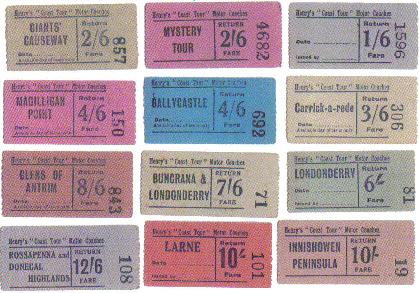

Note the back of the ticket, free advertising!
STAFF
Advertising appeared in the local newspapers.
Booking offices: a kiosk at Portstewart Harbour, outside which was the tour advertising
board now held in the Ulster Folk and Transport Museum (photo on front page of this site).
Bookings could also be made at the garage office in Portstewart and at Miss Mackle's
shop opposite Portrush railway station.
The function of the conductor/canvassers was to deliver tour posters to hotels and guest
houses and in other words obtain custom.
TOUR PROGRAMMES
An example is shown below:
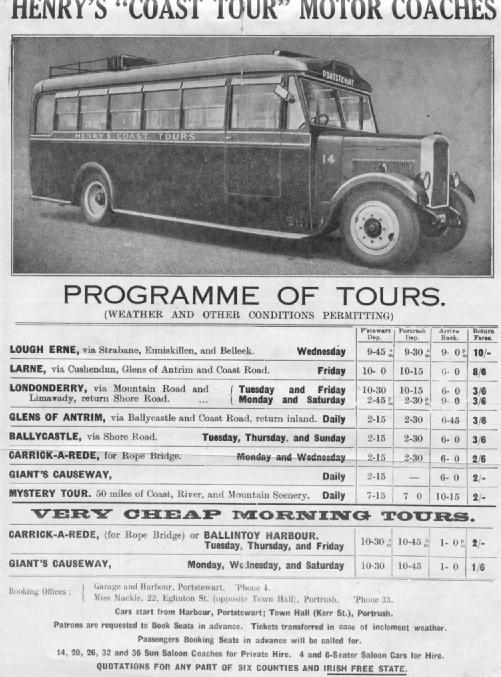
OTHER OPERATING COSTS
Item |
Cost |
Note |
Motor insurance |
£142 12s per annum (including the Irish Free State) |
Cover was third party, fire and theft, with unlimited cover for passengers and public hire. |
Employer's liability |
£5 12s per annum |
|
Fire on property |
£7 1s 3d per annum |
|
Petrol grade 1 |
1s 4d per gallon |
|
Petrol grade 3 |
1s 1 3/4d per gallon |
|
MOTOR TAXATION
Vehicles were only taxed for the period of months needed.
Year |
Vehicles |
1933 |
3 buses under four months |
3 buses five/six months |
1 bus nine months |
1 bus twelve months |
1934 |
1 bus three months |
6 buses four/six months |
1 bus ten months |
1935 |
1 bus two months |
6 buses four/seven months |
2 buses ten months |
Road tax was £24 15s for each bus for a full year. The PSV licence was £2 per
vehicle per year.
PHOTOS
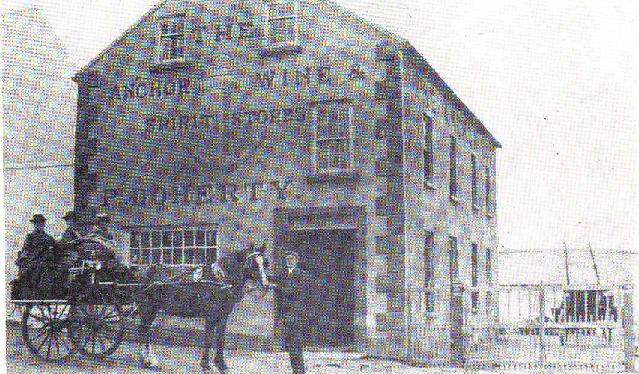
Peter Doherty's licensed premises and jaunting car.
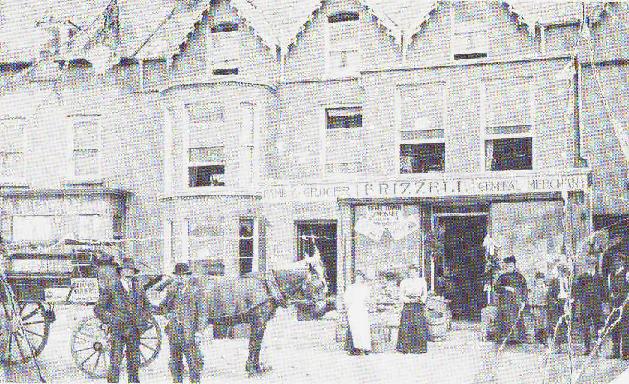
Frizzell's waggonette in 1907
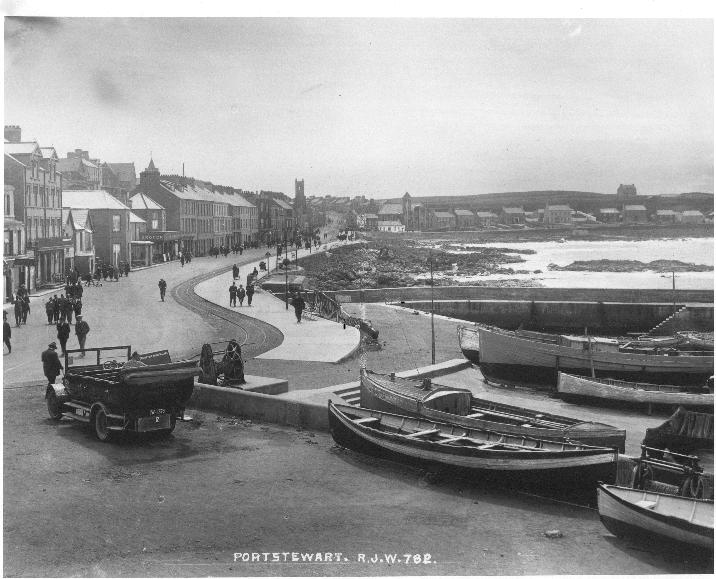
Berliet charabanc number 12 (IW 1379) at Portstewart harbour c. 1922.
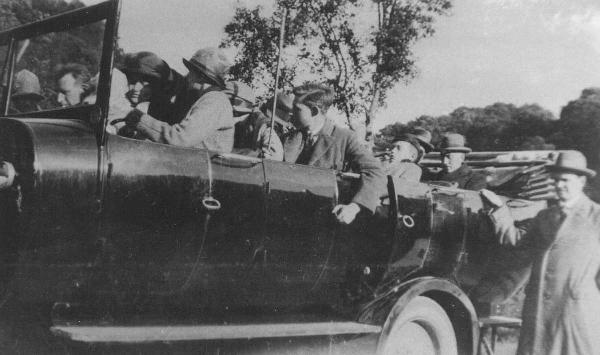
Berliet charabanc number 12 (IW 1379) at Banagher Glen in 1925, with S. S. Henry
driving it.
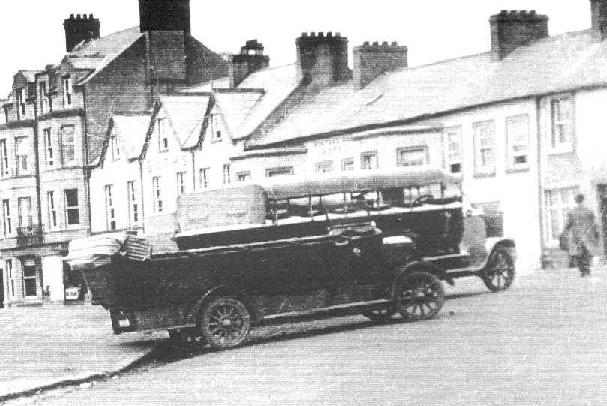
Two of the four Thornycroft charabancs owned are seen at the Crescent in Portstewart
in 1923.
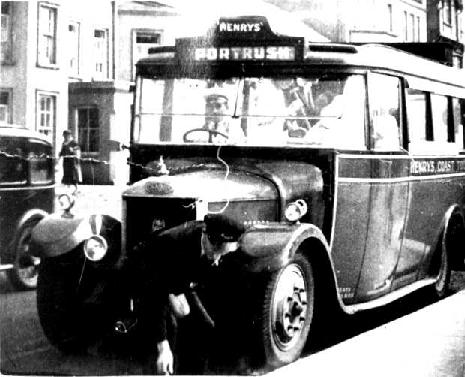
Dennis IW 3786 at the Promenade in 1930.
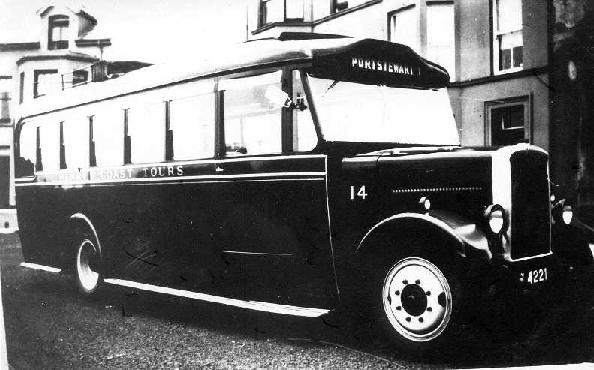
Leyland Cub IW 4221 at the Carrig-na-Cule Hotel in 1932.
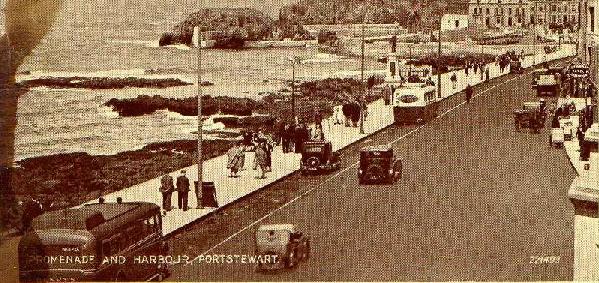
Henry's Leyland Tiger TS5 IW 4235 is visible in the corner of this 1932 postcard view
of Portstewart Harbour, with a Northern Counties Committee bus parked further along the road.
PORTSTEWART TRAMWAY COMPANY LIMITED
In 1855 a branch railway line was constructed from Coleraine to Portrush, skirting
Portstewart a mile and a half to the north-west. A station was erected adjoining the local landlord's estate and named Cromore.
Portrush was benefiting from the railway and in 1861 and an application was made by the Portstewart Tramway Company Ltd. to
construct a tramway from Cromore station to Portstewart; however the landlord opposed this proposal. After a considerable time he
agreed, giving the land free to build a railway of standard gauge (5 ft. 3 in.). Owing to the death of the landlord, the scheme was
shelved until 1882, when a 3 ft. gauge line was constructed.
The tramway was the first roadside 3 ft. gauge steam tramway in Ireland to open, and 44
years later also the first to close. Initially the tramway was profitable, however in 1892 a mortgage holder requested repayment.
This was not possible and S. R. Henry was appointed as receiver. A petition for winding up was presented and accordingly the company
was offered for sale, the Belfast and Northern Counties Railway offered £2,100. The receiver confirmed that this would
liquidate all claims and pay off the mortgages. The company was sold to the B. and N. C. R. on 1st June 1897. Considerable
expenditure was incurred by the railway company, including a new locomotive. However in September 1925 a decision was made to close
the tramway on 30th January 1926. A bus service was then provided by S. S. Henry.
OTHER BUS OPERATORS IN PORTSTEWART
REID.
No details known.
C. TINSLEY.
Had a confectionery/tobacconist shop on the Promenade. His buses may have been named the
big nut and the wee nut.
PETER DOHERTY.
A publican, who also operated as Anchor Motor Services and had the following buses:
IW 2831 1926 Dennis 17 seater
IW 3040 1927 Dennis 18 seater
IW 3348 1928 Dennis 19 seater
He provided a half-hourly service between Portstewart and Coleraine, and his fleet was
nicknamed canaries due to their yellow livery. The business was taken over by the N. C. C. in October 1929. His sister Maisie
maintained she was the first female to hold a p. s. v. licence in Ulster.
A. FRIZZELL.
A general merchant in Portstewart, who operated the following vehicles:
XI 4659 1925 Morris 14 seater
IW 3115 1927 Morris 14 seater
IW 3371 1928 Chevrolet 14 seater
His vehicles had been used for tours and a shuttle service between Portstewart and
Portrush during the summer since the mid-1920s. His business was acquired by the Northern Counties Committee on 17th February 1930.
NORTHERN COUNTIES COMMITTEE.
This railway company operated between Portstewart and Portrush, possibly after they
acquired Frizzell's business. At 1st July 1932 the standard fares were 4d single and 6d return. On 1st January 1932 they took over
the Portstewart to Portstewart station service from S. S. Henry.
VEHICLE OPERATORS IN NORTHERN IRELAND.
In 1932 the three railway companies, Belfast and County Down, Great Northern and
Northern Counties Committee, formally asked the Government for the creation of a monopoly over road transport in Ulster. A report
was to be prepared by Sir Felix J. Pole (former manager of the Great Western Railway) regarding the integration of road and rail
transport in Northern Ireland. His proposals were accepted by the Government, and authority was given to the Road and Railway
Transport Act of July 1935. Within six months of this date the Board issued vesting orders for the undertakings to be acquired.
On 1st October 1935 the three railway companies, together with the Belfast Omnibus
Company and H. M. S. Catherwood Ltd., commonly referred to as the big five, handed over their vehicles and accepted the proposed
offer of compensation. Most of the other operators also accepted the offer, but some of the remainder fought for a better deal,
mainly for the goodwill element, and negotiated an acceptable settlement (details of the statistics required are shown in appendix G).
Settlement was made on the depreciated cost of the assets plus the goodwill. Negotiations took place over a period of more than a
year (details of the claim and settlement for S. S. Henry are shown in appendix H).
ARBITRATION.
In S. S. Henry's claim, a number of expert witnesses were called to present their cases,
all their documented evidence has been retained. The only evidence from the N. I. R. T. B. was a letter from A. Rea (see Appendix I),
presumably a manager or employee in Coleraine depot, to Major Speir, the General Manager and Secretary of the N. C. C. in Belfast.
ANECDOTES.
David Bacon, one of the Henry drivers who transferred to the N. I. R. T. B., was sent to
Belfast to bring a double decker bus to Coleraine depot. On the journey home there was a low railway bridge on the approach to
Templepatrick and David, who did not realise the restricted height of the bridge, kept to his own side of the road, and sliced the
top off the bus. For some time afterwards it was called Bacon's Bridge!
LOADING PROBLEM.
In 1924 S. S. Henry went to Manchester and purchased NC 4903 from Pemberton of
Manchester. When he arrived at the docks he found there was no equipment available to load the charabanc. He got two planks and laid
them from the dock to the boat. When the tide raised the boat to the correct level he drove on board and journeyed home.
LOCAL COMMENT.
The late William Archibald wrote the following to me:
The average wages paid were good by the standards of the time, when an unskilled
labourer was earning £1 per week. Having a skilled work-force must have added to the success of the enterprise. With the virtue
of hindsight, the legislation which nationalised road transport was totally unnecessary. In an effort to regulate what the
Government saw as the chaotic state of public transport, the baby was thrown out with the bath water. Many small operators of one or
two buses were running on a shoestring, unable to afford either replacements or repairs. If the Government had not interfered,
market forces would have insured that the smaller weaker undertakings would have been absorbed by the successful ones.
OVERCROWDING.
The following report appeared in the Belfast Telegraph dated August 3rd 1928:
COLERAINE MOTOR CASES
FINES FOR OVERCROWDING
District-Inspector Robinson summoned Bertie Symton, 5 Mark Street, Portrush, conductor,
and H. M. S. Catherwood, owner, for permitting overcrowding in a bus. There were 46 passengers on the bus, which was licensed to
carry 36. Symton was fined 25s and Catherwood 30s.
Same Complainant summoned John J. Doyle, 5 Mark Street, Portrush, conductor, and H. M. S.
Catherwood, owner, for a similar offence. In this case there were 41 passengers, whereas the bus was licensed to carry 36. Doyle was
fined 12s 6d and Catherwood 30s.
In a like case against Daniel McGowan, Coleraine Road, Portstewart, conductor, and
Samuel S. Henry, Portstewart, owner, fines of 10s and 30s respectively were imposed. There were 21 people in the bus which was
licensed to carry 17.
Joseph McLean, Ballyronan, Magherafelt, was fined £1 for using a motor-cycle
without a driver's licence.
For a similar offence Archibald P. Reid was fined 7s 6d.
Thomas Millen, Lyle Hill, Templepatrick, was fined 2s 6d for driving a motor-car, the
licence for which having expired on 1st July was not renewed.
Alex. Sharpe, 5 Mark Street, Portrush, conductor, and H. M. S. Catherwood, owner, were
fined 12s 6d and 30s respectively for permitting overcrowding in a bus.
CHARABANC LICENSING.
In P. E. Greer's book, Road Versus Rail - 1982, he states:
A few years ago, one of our members inaugurated a charabanc service between
Portstewart and Portrush, which was supported extensively by the travelling public, and it was because he succeeded in catering for,
and supplying to the public at reasonable rates, a service which was much needed that the appeal for power to licence charabancs has
been brought forward. The desire for this power emanated from these two councils, who have been prosecuting and persecuting this
member, and using any and every means to put him off the road. Portstewart Urban Council issued sixteen summonses against him, but
failed to succeed on any of them, the cause of complaints being utterly groundless, thus demonstrating the misuse such a council
would make of further powers. There was no service between these two places until our member introduced it, only small cars being
available at exorbitant rates. These two councils canvassed all the other councils and appealed to them to join them in demanding
power to license and control charabancs.
Go back to homepage
Go to appendices section
Any corrections to the content of this website, or copies of additional photos, tickets,
publicity material or other information would be gratefully received and added to the archve.
E-mail the webmaster if you can help.
Website compiled by S. R. Henry, September 2004.
SB


















